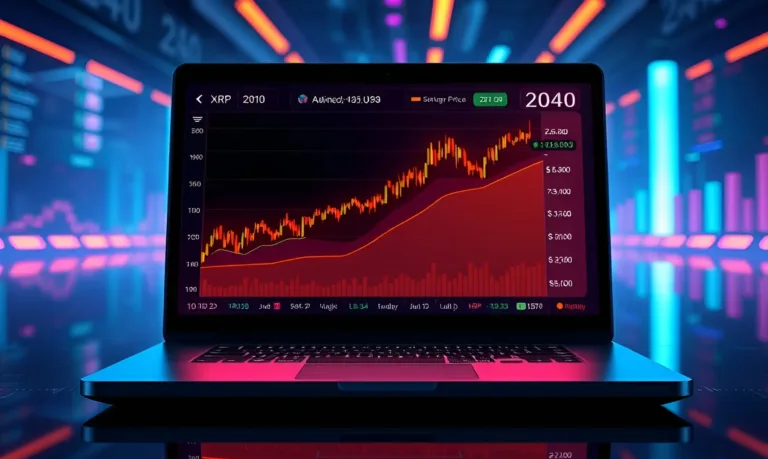How Much Will 1 Bitcoin Be Worth in 2035?
Predicting the value of one Bitcoin in 2035 involves several variable factors. Historical trends show significant volatility, with peaks and troughs in valuation.
Market demand is influenced by regulatory environments and technological advancements. Increased adoption rates and potential institutional investment may drive prices higher.
However, risks such as regulatory uncertainty, technological vulnerabilities, and environmental concerns pose challenges. Understanding these dynamics will provide insights into Bitcoin’s future trajectory and how it shapes the broader financial landscape.
Principal Conclusions
ShowThe Historical Price Trends of Bitcoin

The historical price trends of Bitcoin illustrate a volatile yet upward trajectory since its inception in 2009. Initially valued at less than one cent, Bitcoin experienced significant price fluctuations, peaking near $20,000 in December 2017 before crashing to around $3,000 in early 2019.
Subsequent years saw a gradual recovery, culminating in a new all-time high of approximately $64,000 in April 2021, driven by increased institutional adoption and mainstream awareness. The price fluctuated again, settling between $30,000 and $60,000 throughout 2021 and 2022.
Factors Influencing Bitcoin’s Future Value
The future value of Bitcoin is markedly shaped by market demand dynamics and changes in the regulatory environment.
Market demand is influenced by factors such as investor sentiment, technological advancements, and competition from alternative cryptocurrencies.
Additionally, regulatory shifts can either foster growth through legitimacy or constrain the market through restrictions, impacting overall adoption and valuation.
Market Demand Dynamics

Numerous factors shape the market demand dynamics that will influence Bitcoin’s future value. Among these, technological advancements in blockchain and increasing transaction efficiency can enhance Bitcoin’s attractiveness as a digital asset.
Additionally, the growing acceptance of cryptocurrencies by mainstream institutions and businesses can bolster demand, as evidenced by rising institutional investments.
Market sentiment, driven by social media trends and public perception, plays a critical role in price fluctuations.
Moreover, macroeconomic factors, including inflation rates and currency stability, can drive investors towards Bitcoin as a hedge against traditional financial systems.
Finally, the scarcity of Bitcoin, governed by its capped supply, will inherently influence its value, particularly as demand increases over time.
Regulatory Environment Changes
As regulatory frameworks surrounding cryptocurrencies evolve, their impact on Bitcoin’s future value becomes increasingly significant.
Governments worldwide are adopting diverse approaches, ranging from outright bans to extensive regulatory structures. For instance, countries like El Salvador have embraced Bitcoin as legal tender, while others impose strict regulations or taxation policies.
This divergence creates uncertainty in the market, influencing investor sentiment and adoption rates. Additionally, regulatory clarity can lead to increased institutional investment, enhancing Bitcoin’s legitimacy.
Conversely, stringent regulations may stifle innovation and limit market participation. As these regulatory landscapes develop, they will shape the demand, accessibility, and ultimately the valuation of Bitcoin in the coming years, particularly as the 2035 horizon approaches.
Adoption Rates and Market Demand

While the trajectory of Bitcoin’s value is influenced by various factors, adoption rates and market demand stand out as critical determinants.
Historical data indicates that increased adoption correlates with significant price surges. For instance, the 2020-2021 bull run was largely attributed to institutional investments and growing retail interest, highlighting the importance of market sentiment.
Furthermore, metrics such as wallet addresses and transaction volumes serve as indicators of user engagement and demand.
Projections for 2035 suggest that if adoption continues to rise, bolstered by advancements in technology and education, market demand may increase substantially.
This scenario would likely drive Bitcoin’s value higher, contingent upon the interplay between supply dynamics and the broader economic environment.
Regulatory Landscape and Its Impact
Regulatory frameworks play an essential role in shaping the landscape for Bitcoin and its value in the coming years.
As governments worldwide develop and implement regulations, they can either promote stability and growth or impose restrictions that hinder market participation.
For instance, stringent regulations may reduce speculative trading and increase compliance costs, potentially driving investors away. Conversely, a clear regulatory framework could enhance trust and attract institutional investors, thereby stabilizing prices.
The evolving nature of regulations, including taxation policies and security classifications, will greatly impact Bitcoin’s market dynamics.
Historical data suggests that regulatory clarity often correlates with price increases, underscoring the importance of a balanced approach that fosters innovation while ensuring consumer protection.
Technological Advancements in Blockchain

Recent technological advancements in blockchain are poised to greatly influence Bitcoin’s value trajectory by enhancing scalability, security, and transaction efficiency.
As the blockchain ecosystem evolves, several key innovations emerge:
- Layer 2 Solutions: Technologies like the Lightning Network facilitate faster transactions by processing them off-chain, reducing congestion and fees.
- Smart Contracts: Enhanced programmability allows for automated, trustless transactions that can integrate Bitcoin into various applications, increasing its utility.
- Interoperability Protocols: Solutions that enable cross-chain interactions can create a more connected environment, enhancing Bitcoin’s role in the broader cryptocurrency landscape.
These advancements not only contribute to Bitcoin’s efficiency but also bolster investor confidence, which may lead to increased demand and, ultimately, a higher market value in the years ahead.
Expert Predictions for Bitcoin in 2035

Experts predict that Bitcoin’s value in 2035 will be greatly shaped by prevailing market trends, technological advancements, and the evolving regulatory environment.
Analysis of historical data suggests that these factors will collectively influence investor confidence and adoption rates.
For this reason, a thorough understanding of these dynamics is essential for forecasting Bitcoin’s future trajectory.
Market Trends and Analysis
How might the market landscape for Bitcoin evolve by 2035? Analysts predict several key trends that could notably shape Bitcoin’s value and adoption.
- Increased Institutional Investment: A growing number of institutional investors may enter the market, bolstering Bitcoin’s legitimacy and driving demand.
- Regulatory Developments: Governments worldwide are likely to implement clearer regulations, potentially influencing market stability and investor confidence.
- Global Economic Factors: Economic instability or inflation in various regions might lead investors to seek Bitcoin as a hedge, increasing its market value.
These factors, combined with enhanced public awareness and technological integration, could create a more robust market environment for Bitcoin, leading to varied predictions about its value by 2035.
Technological Advancements Impact
Technological advancements are poised to greatly influence Bitcoin’s trajectory by 2035, shaping both its functionality and user adoption.
Innovations such as the implementation of layer-two solutions, like the Lightning Network, are expected to enhance transaction speed and reduce costs, making Bitcoin more practical for everyday use.
Additionally, advancements in blockchain interoperability may facilitate better integration with other digital assets and platforms, potentially broadening its appeal.
Enhanced security protocols, including quantum-resistant cryptography, could also bolster user confidence and protect against emerging threats.
Moreover, the rise of decentralized finance (DeFi) applications may drive increased utility for Bitcoin, positioning it as a cornerstone of a more integrated digital economy. These technological changes could collectively influence Bitcoin’s valuation and user engagement in 2035.
Regulatory Environment Influence
As the regulatory landscape evolves, its influence on Bitcoin’s value and adoption by 2035 will likely become increasingly significant. Analysts predict that the nature of regulations could shape the market in several key ways:
- Legal Frameworks: Countries may establish clearer guidelines, enhancing institutional investment and consumer confidence.
- Taxation Policies: Differing tax treatments for cryptocurrencies could either incentivize or deter investment, impacting demand.
- Interoperability Standards: Harmonized regulations across jurisdictions may facilitate smoother transactions and integration into existing financial systems.
These factors are anticipated to play a vital role in determining Bitcoin’s market maturity, stability, and overall value.
The regulatory environment will not only dictate how Bitcoin operates but also influence public perception and the cryptocurrency’s potential as a mainstream asset by 2035.
Risks and Challenges Ahead for Bitcoin
While the potential for Bitcoin to transform the financial landscape continues to attract attention, various risks and challenges loom on the horizon that could impede its growth.
Regulatory uncertainty, technological vulnerabilities, and market volatility are significant concerns that may affect investor confidence and adoption rates. Additionally, environmental implications of Bitcoin mining have drawn criticism, potentially leading to stricter regulations.
| Risk Factor | Description |
|---|---|
| Regulatory Uncertainty | Inconsistent global regulations may hinder growth. |
| Technological Vulnerabilities | Potential security flaws could undermine trust. |
| Market Volatility | Price fluctuations can deter institutional investors. |
| Environmental Concerns | High energy consumption may lead to regulatory backlash. |
These factors necessitate ongoing scrutiny as Bitcoin evolves within a complex economic landscape.
Wrapping Up
To conclude, predicting the worth of one Bitcoin in 2035 is akin to forecasting the trajectory of a comet. Historical price trends, adoption rates, and regulatory developments all serve as gravitational forces affecting its path.
As the cryptocurrency landscape evolves, experts remain divided, much like astronomers debating a comet’s return.
With potential risks and technological advancements on the horizon, Bitcoin’s future value will depend on how these factors align in the coming years, shaping its orbit in the financial universe.







